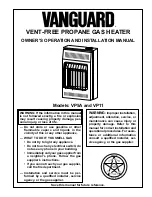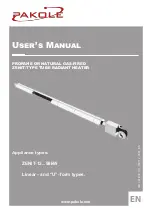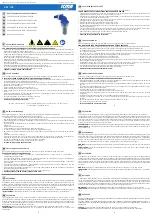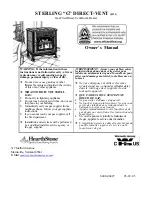
22
SAFETY EQUIPMENT
For protection against excessive pressures in the collector
loop a pressure relief valve is integrated into the solar
pump station. Drain tubing must be installed in the valve
outlet so that any discharge will exit only within 6 inches
above, or at any distance below the structural fl oor. Be
certain that no contact is made with any live electrical part.
The discharge opening must not be blocked or reduced in
size under any circumstances. Excessive length, over 15
feet, or use of more than two elbows can cause restriction
and reduce the discharge capacity of the valve.
Do not connect tubing directly to discharge drain unless a
6” air gap is provided. To prevent bodily injury, hazard to
life, or damage to property, the relief valve must be allowed
to discharge fl uid in quantities should circumstances
demand. If the discharge pipe is not connected to a drain
or other suitable means, the fl uid may cause property
damage.
ATTENTION:
TO PREVENT DAMAGE TO PROPERTY,
THE LOCATION OF INSTALLATION MUST BE DRY,
LOAD-CARRYING AND FROST-PROOF TO PREVENT
MATERIAL DAMAGE TO THE INSTALLATION.
When following the ‘PUMP STATION INSTALLATION’ see
Figure 21.
WALL MOUNTING THE SOLAR PUMP STATION
1. Choose the position to install the solar pump station
next to the storage tank .
2. Mark the location of the hanging holes on the wall (15”
apart vertically)
CAUTION
DUE TO THE WEIGHT OF THE SOLEX PUMP STATION THE
HANGAR ANCHORS MUST BE ATTACHED TO A STRUCTURAL
SUPPORT LIKE A STUD
3. Pre-drill holes and insert the enclosed 4.5” hanging
screws so that about 1” of each screw still stick out..
4. Remove the front cover of the solar station and hang
the station onto the screws then tighten the screws.
5. Mount the solar safety group to the connection above
the return ball valve.
CONNECTION FOR
EXPANSION TANK
CONNECTION FOR
DISCHARGE LINE
DRAIN
VALVE
CONNECTION SET
WITH EXPANSION TANK
Figure 22.
6. Connect a discharge line to the pressure relief valve
in the solar circuit
7. Connect the stainless steel corrugated hose to the
safety group. Do not forget to insert the seal.
8. Choose the position for the expansion tank bracket
on the wall beside the solar pump station. Fasten the
bracket to the wall with the enclosed hardware (masonry
or drywall).
9. Unscrew the tank connector to separate the two halves.
The top half should be pushed onto the mounting
bracket and the lock ring tightened. The bottom half
should be attached to the ¾” threads on the expansion
tank.
NOTE:
The tank connector allows you to isolate the
expansion tank from the solar circuit. See Figure 23. When
the nut is unscrewed the valves in each half of the tank
connector are automatically closed tightly by the integrated
springs. Each side remains closed until the two halves are
screwed back together and the valves are forced open. Do
not forget to insert the seal.
The expansion tank should not be connected to the system
until it has been flushed and charged.
FLOW
CLOSED
Figure 23.
10. Check and set the pressure of the air bladder in the
expansion tank to 25 psi. If the pressure is higher bleed
pressure out until it is correct. If the pressure is too low
add air by use of a compressor or bicycle pump until
the pressure is correct.
11. Plumb the solar pump station to the storage tank
and to the collector: The tank connections should
use ¾” copper pipe and can be connected using
the threaded adaptors provided. The collector
connections should use ½” copper pipe and can be
connected with the compression fittings provided.
The total piping run in the solar loop should not exceed
200 equivalent feet. Failure to limit the line length may
cause poor system performance and lead to premature
pump failure.
12. Install a discharge pipe to the pump station relief valve
that must terminate a maximum of six inches above a
floor drain or external to the building.
PUMP STATION INSTALLATION
Summary of Contents for SRCC OG-100
Page 3: ...3 GENERAL SAFETY...
Page 40: ...40...
















































